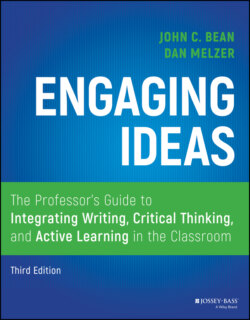Читать книгу Engaging Ideas - John C. Bean - Страница 23
Structure of the Book
ОглавлениеChapter 1, designed for the busy professor, provides a nutshell compendium of the whole book. It also addresses four misconceptions that tend to discourage professors from integrating writing and critical thinking assignments into their courses.
Part 1 (chapters 2 and 3) examines the scholarship and theory that links writing to thinking. Chapter 2 focuses on critical thinking and writing, arguing that good writing is a process and a product of critical thought. Chapter 3 examines the rhetorical dimension of thinking and writing, showing how writers must think rhetorically about purpose, audience, genre, and discourse communities. It argues that writing and critical thinking skills are enhanced when students are asked to write in different genres for different kinds of audiences and purposes.
Part 2 (chapters 4 and 5) focuses on the design of problem‐based writing assignments for promoting critical thinking. Chapter 4 covers the design of formal writing assignments that go through multiple drafts toward becoming a finished product. By contrast, chapter 5 explains the use of low‐stakes, exploratory writing inside and outside of class to enhance learning and promote critical thinking.
Part 3 (chapters 6 through 10) offers a compendium of strategies for coaching students as learners, thinkers, and writers. Using examples from across the curriculum, chapter 6 presents a heuristic for designing critical thinking problems that promote active learning. These problems can be used as prompts for formal or informal writing assignments, as tasks for small‐group problem‐solving, or as ways to stimulate class discussion or enliven lectures. Chapter 7, on mindful reading, explores the difference between surface reading and deep reading, showing how instructors can strengthen students' reading skills by helping them think rhetorically about texts and metacognitively about their own reading processes. Chapters 8 and 9 together discuss ways to use class time for active inquiry and critical thinking. Chapter 8 focuses on the use of small groups in the classroom, and chapter 9 suggests ways to make lectures more interactive and whole‐class discussions more productive. Chapter 10, on teaching undergraduate research, argues that the conventional “research paper” is an academic pseudo‐genre that needs to be replaced by authentic research projects written in appropriate disciplinary genres. It offers advice for helping students think metacognitively about the way different disciplines ask questions, gather evidence, make arguments, and position themselves in a conversation with other scholars. It argues that skills needed for advanced research writing at the end of the major are best taught through strategically designed scaffolding assignments earlier in the curriculum.
The final section of the book, part 4 (chapters 11–16), concerns strategies for responding to and grading student writing. Chapter 11, new to this edition, presents the happy news that students can use metacognitive reflection to self‐assess their own drafts in progress and can conduct effective peer reviews that match the quality of teacher reviews. Chapter 12 offers advice on creating and using rubrics, which can clarify an instructor's grading criteria and, in many cases, decrease an instructor's time spent grading and commenting on papers. Chapter 13 offers ten time‐saving strategies for coaching the writing process while avoiding teacher burnout. Chapter 14 focuses on ways to write supportive comments on students' work to promote significant revision rather than justify a grade. Chapter 15, on responding to grammar and other sentence‐level concerns, is a substantial revision of the second edition's chapter 5. While still focusing on the importance of careful sentence‐level editing it now tries to incorporate a more progressive, translingual appreciation of language diversity. Finally, chapter 16, also new to the third edition, explains alternatives to traditional grading through portfolio assessment and contract grading.
